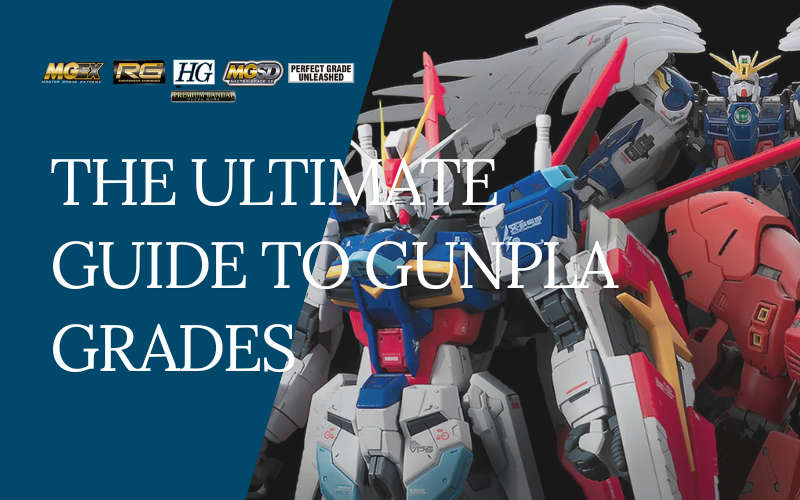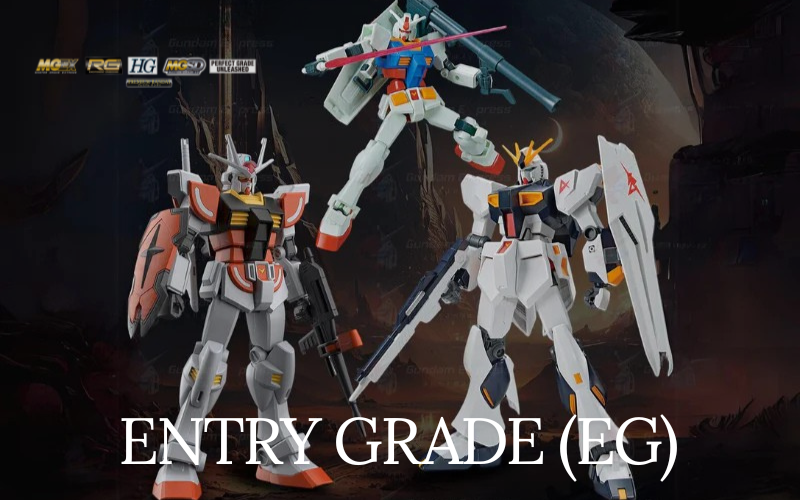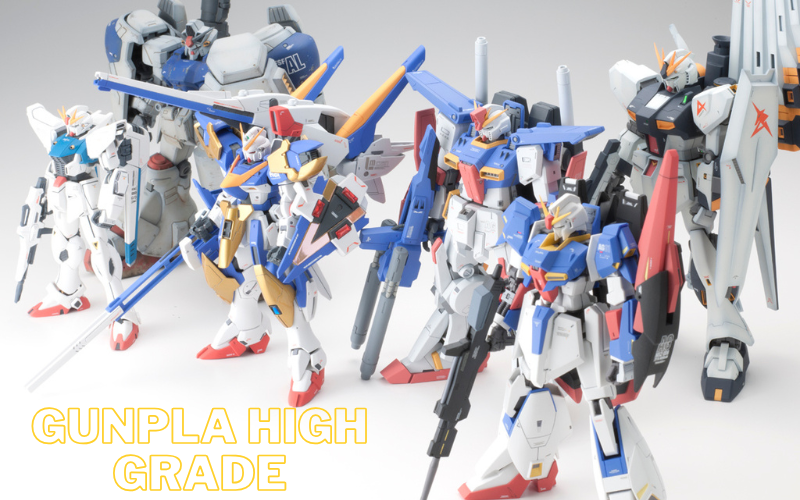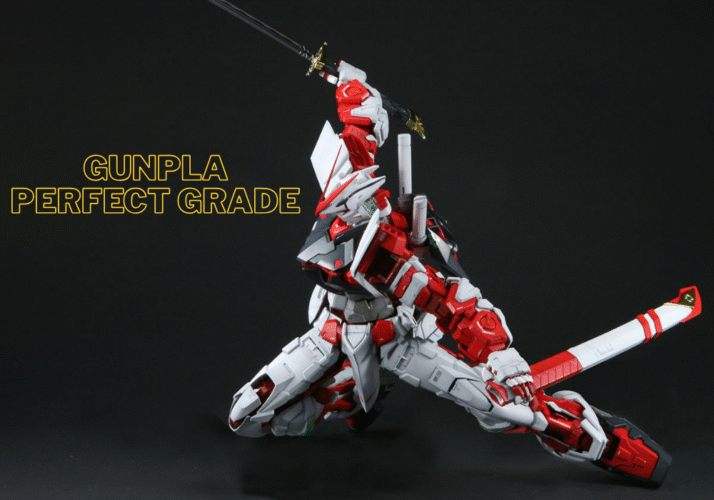Walking into a hobby store and seeing rows of Gunpla boxes with mysterious acronyms like HG, RG, MG, and PG can feel overwhelming. You’re not alone in wondering what these grades mean and which one is right for you. The Gunpla grading system is your roadmap to finding the perfect kit that matches your skill level, available time, and budget—transforming what seems like confusing marketing jargon into your gateway to an incredibly rewarding hobby.
This comprehensive guide will decode every Gunpla grade, provide direct comparisons, and give you the confidence to choose your next build. Whether you’re picking up your first kit or considering stepping up to more advanced grades, you’ll have all the information you need to make the perfect choice.
Key Takeaways
• Entry Grade (EG) and High Grade (HG) are perfect starting points for beginners, requiring minimal tools and offering excellent value • Real Grade (RG) provides Master Grade-level detail in a smaller 1/144 scale but requires intermediate skills • Master Grade (MG) offers the best balance of size, detail, and building experience for serious hobbyists • Perfect Grade (PG) represents the pinnacle of Gunpla technology but requires expert-level skills and significant time investment • The grade system serves as a natural progression path, allowing builders to advance their skills gradually
What Are Gunpla Grades? A Quick Overview
Gunpla grades are Bandai Spirits’ official classification system for their plastic model kits, categorizing them based on scale, parts complexity, internal detail, and technological features. Think of grades as difficulty levels in a video game—each one builds upon the previous, introducing new challenges and rewards.

The grading system isn’t just about complexity; it’s about different building experiences. A High Grade focuses on accessibility and variety, while a Perfect Grade showcases cutting-edge engineering. Understanding these distinctions is the single most important concept for any Gunpla builder to grasp, as it directly impacts your enjoyment and success with the hobby.
The Ultimate Gunpla Grade Comparison Chart
| Grade | Acronym | Scale | Average Height | Skill Level | Price Range | Key Features |
|---|---|---|---|---|---|---|
| Entry Grade | EG | 1/144 | ~13 cm | Absolute Beginner | $15-25 | Snap-fit, no tools required, limited parts, excellent color separation |
| High Grade | HG | 1/144 | ~13 cm | Beginner to Intermediate | $20-40 | Most diverse line, good balance of detail and simplicity, basic tools recommended |
| Real Grade | RG | 1/144 | ~13 cm | Intermediate to Advanced | $35-60 | MG-level detail in smaller scale, full inner frame, complex decals |
| Master Grade | MG | 1/100 | ~18 cm | Intermediate to Advanced | $50-120 | Large scale, detailed inner frame, high articulation, often includes pilot figures |
| Perfect Grade | PG | 1/60 | ~30 cm | Expert | $200-500+ | Pinnacle of Gunpla tech, immense parts count, metal parts and LED systems |
| Super Deformed | SD | Non-Scale | ~8 cm | Beginner | $15-30 | “Chibi” proportions, simple build, focused on fun and stylization |
The Main Gunpla Grades Explained in Detail
Entry Grade (EG): Your Perfect First Step
Entry Grade represents Bandai’s newest approach to welcoming beginners into the hobby. Introduced in 2020 with the iconic RX-78-2 Gundam, EG kits are engineered for absolute simplicity while maintaining impressive visual results.

Scale & Size: 1/144 scale, standing approximately 13 centimeters tall when completed.
Build Experience: These kits require zero tools—everything snaps together by hand. The parts are pre-colored with excellent color separation, meaning the finished model looks great straight out of the box without paint. Build time typically ranges from 30 minutes to 1 hour.
Essential Tools: None required, though a basic panel lining marker can enhance details.
Who Should Build This: Complete beginners, parents building with children, or anyone wanting a quick, satisfying build experience. Perfect for testing if you enjoy the hobby before investing in tools.
Top 3 Recommended Kits:
- RX-78-2 Gundam – The classic that started it all
- Gundam Barbatos – Modern design with great articulation
- Nu Gundam – Iconic late UC design with distinctive funnels
High Grade (HG): The Heart of the Hobby
High Grade represents the sweet spot for most builders—offering the widest variety of mobile suits while maintaining accessibility. Since its revolutionary introduction in 1990, HG has consistently delivered the best value proposition in Gunpla.

Scale & Size: 1/144 scale, typically 13-15 centimeters tall depending on the mobile suit.
Build Experience: More complex than EG with increased parts count and finer details. Builds typically take 2-4 hours and benefit from basic tools like nippers and a hobby knife. Many HG kits include multiple weapon options and action base compatibility.
Essential Tools: Side cutters (nippers), hobby knife, panel lining markers, and sanding sticks for nub cleanup.
Who Should Build This: Anyone who enjoyed EG and wants more detail, builders who want a large collection without breaking the bank, or those who prefer the 1/144 scale’s space efficiency.
Top 3 Recommended Kits:
- RX-78-2 Gundam Revive – The definitive HG experience
- Gundam Barbatos – Excellent articulation and modern engineering
- Zaku II – Classic enemy suit with great character
The HG line benefits from Bandai’s “Real Type” color separation technology, ensuring that even basic builds look screen-accurate. This makes HG perfect for builders who want impressive results without the time commitment of higher grades.
Real Grade (RG): Maximum Detail in a Small Package
Real Grade, launched in 2010 for Gunpla’s 30th anniversary, represents Bandai’s engineering showcase—cramming Master Grade-level detail and complexity into the compact 1/144 scale.
Scale & Size: 1/144 scale, but with significantly more presence than HG due to increased detail density.

Build Experience: RG kits feature full inner frames, advanced articulation systems, and incredibly detailed exterior armor. Build times range from 4-8 hours, with intricate water-slide decal sheets that can double the completion time if applied.
Essential Tools: All HG tools plus water-slide decal solution, setting solution, and potentially an airbrush for advanced finishing.
Who Should Build This: Intermediate builders who want maximum detail in minimum space, collectors with limited display area, or those who enjoy intricate, technical builds.
Top 3 Recommended Kits:
- RX-78-2 Gundam – The RG that perfected the formula
- Wing Gundam Zero EW – Stunning transformation and wing effects
- Nu Gundam – Recent engineering masterpiece with excellent proportions
RG kits often include innovative gimmicks like transformations or detachable equipment that showcase Bandai’s latest engineering techniques. However, the high parts count and small pieces require patience and steady hands.
Master Grade (MG): The Builder’s Choice
Master Grade, introduced in 1995, established the gold standard for detailed Gunpla builds. The 1/100 scale provides enough size for intricate internal detail while remaining manageable for most builders.
Scale & Size: 1/100 scale, standing 18-20 centimeters tall with commanding shelf presence.

Build Experience: MG kits feature fully detailed inner frames that are enjoyable to build on their own. Many include pilot figures, opening cockpits, and advanced gimmicks. Build times typically range from 6-12 hours across multiple sessions.
Essential Tools: Complete tool set including nippers, hobby knife, panel lining supplies, and potentially pin vise for small modifications.
Who Should Build This: Serious hobbyists who want the full Gunpla experience, builders ready to invest significant time in a single kit, or those who prefer larger, more detailed displays.
Top 3 Recommended Kits:
- RX-78-2 Gundam Ver. 3.0 – The perfect MG starting point
- Barbatos – Modern engineering with excellent articulation
- Sazabi Ver. Ka – Hajime Katoki’s design masterpiece
Master Grade Ver. Ka (Version Katoki) kits represent the premium MG experience, featuring redesigns by legendary mecha designer Hajime Katoki and additional detail parts.
Perfect Grade (PG): The Ultimate Gunpla Challenge
Perfect Grade represents the absolute pinnacle of Gunpla engineering. Since 1998, PG has pushed the boundaries of what’s possible in plastic model kits, often incorporating metal parts, LED systems, and revolutionary construction techniques.

Scale & Size: 1/60 scale, standing an impressive 30+ centimeters tall with massive shelf presence.
Build Experience: PG builds are projects that can take 20-40+ hours to complete. They often include multiple lighting systems, opening panels, detailed cockpits with pilot figures, and incredibly complex transformation mechanisms.
Essential Tools: Master-level tool collection including specialized equipment for electronics installation and advanced finishing techniques.
Who Should Build This: Expert builders ready for a month-long project, those with dedicated workspace for large builds, or collectors seeking the ultimate centerpiece model.
Top 3 Recommended Kits:
- RX-78-2 Gundam Unleashed – The newest PG showcasing latest technology
- Wing Gundam Zero Custom – Classic PG with stunning transformation
- Strike Freedom – LED-equipped technological showcase
According to Bandai Namco’s latest financial reports, Perfect Grade sales represent a small but highly profitable segment, with each kit taking months of development and testing.
Super Deformed (SD): Fun, Stylized, and Fast
Super Deformed kits embrace the “chibi” aesthetic, transforming serious war machines into adorable, stylized characters. This line focuses on fun and personality over realism.

Scale & Size: Non-scale, typically 8-10 centimeters tall with exaggerated proportions.
Build Experience: Simple snap-fit construction similar to EG, but with unique proportions and often whimsical accessories. Build times range from 30 minutes to 2 hours.
Essential Tools: Usually none required, though panel lining can add character.
Who Should Build This: Anyone wanting a fun, stress-free build experience, builders who enjoy cute character designs, or those introducing children to the hobby.
Top 3 Recommended Kits:
- SD Gundam Cross Silhouette RX-78-2 – Modern SD engineering
- SD Nu Gundam – Adorable take on the iconic design
- SD Barbatos – IBO’s brutish design in cute form
Grade vs. Grade: Head-to-Head Comparisons
HG vs. RG: Is the Extra Detail Worth the Complexity?
This comparison represents the most common upgrade decision for intermediate builders. Both grades share the space-efficient 1/144 scale but offer dramatically different experiences.
High Grade Advantages:
- Faster builds (2-4 hours vs. 4-8 hours)
- Lower cost ($20-40 vs. $35-60)
- Less intimidating for newer builders
- Wider variety of available mobile suits
- Simple sticker application vs. complex water slides
Real Grade Advantages:
- Significantly more detail and panel lines
- Full inner frame provides better articulation
- Screen-accurate proportions and color separation
- Premium building experience with advanced techniques
- Better value for display-focused collectors
The Verdict: Choose HG if you want to build many different mobile suits or prefer quicker, more relaxed builds. Choose RG if you want fewer, highly detailed models and enjoy technical challenges.
RG vs. MG: A Battle of Detail Density vs. Scale Presence
This comparison often confuses builders because both offer “premium” experiences but in different ways.
Real Grade Advantages:
- Space-efficient for limited display areas
- Often features latest Bandai engineering innovations
- Lower price point for premium detail
- Consistent 1/144 scale across your collection
Master Grade Advantages:
- Larger size provides better visual impact
- Easier to handle during building process
- Often includes pilot figures and detailed cockpits
- Better articulation due to larger joints
- More forgiving for beginners to advanced techniques
The Verdict: RG maximizes detail per square inch of display space, while MG maximizes building enjoyment and visual impact. Consider your display space and building preferences.
MG vs. PG: A Question of Time, Space, and Budget
The jump from Master Grade to Perfect Grade represents the biggest step in the Gunpla hierarchy.
Master Grade Advantages:
- Manageable build time for working adults
- Reasonable price point for regular purchases
- Fits in standard display cases
- Wide variety of available designs
- Good introduction to advanced techniques
Perfect Grade Advantages:
- Unmatched visual impact and engineering showcase
- Often includes unique features like LED systems
- Ultimate building challenge and satisfaction
- Conversation piece and collection centerpiece
- Latest Bandai technology demonstration
The Verdict: MG offers the best overall balance for most builders, while PG provides once-or-twice-yearly project experiences for dedicated enthusiasts.
Beyond the Basics: Specialized and Niche Gunpla Grades
Ver. Ka (Version Katoki): The Designer’s Touch
Ver. Ka kits represent collaborations with legendary mecha designer Hajime Katoki, featuring his signature design refinements and additional detail parts. These Master Grade kits often include extra weapons, effect parts, and premium decal sheets.
Notable Ver. Ka Features:
- Katoki’s distinctive mechanical detailing
- Premium water-slide decal sheets
- Additional weapons and equipment
- Enhanced articulation systems
- Limited production runs increasing collectibility
MGEX & MGSD: The Cutting Edge of Gunpla Technology
Master Grade Extreme (MGEX) represents Bandai’s premium MG line, incorporating Perfect Grade-level features into the 1/100 scale. These kits often include LED systems, metal parts, and revolutionary construction techniques.
Master Grade Super Deformed (MGSD) combines MG-level engineering with SD proportions, creating highly articulated chibi models with surprising complexity.
Full Mechanics & RE/100: 1/100 Scale Without MG Complexity
These lines offer 1/100 scale size without the complex inner frames of Master Grade, providing good value for builders who want size but prefer simpler construction.
Full Mechanics focuses on newer designs from recent series, while RE/100 (Reborn-One Hundred) revives classic designs that never received Master Grade treatment.
Mega Size, Hi-Resolution (HiRM), and First Grade (FG)
Mega Size kits scale up popular designs to massive 1/48 proportions for maximum impact. Hi-Resolution Model (HiRM) represents Bandai’s premium line with pre-painted details and premium materials. First Grade (FG) serves as the historical predecessor to modern High Grade, now largely discontinued.
The History and Business of Gunpla: Why Grades Exist
The Gunpla grading system evolved from practical manufacturing and marketing needs. When Gundam plastic models first launched in 1980, they were simple, glue-required kits similar to traditional aircraft models.
The revolutionary High Grade line, introduced in 1990 for Gunpla’s 10th anniversary, pioneered snap-fit assembly and “System Injection” molding. This innovation eliminated the need for glue and extensive painting, making the hobby accessible to a much broader audience.
Master Grade followed in 1995, establishing the 1/100 scale standard and introducing detailed internal skeletons. Perfect Grade arrived in 1998, pushing engineering boundaries with the massive RX-78-2 that included unprecedented detail and gimmicks.
The business success has been remarkable. According to Bandai Spirits’ corporate data, total Gunpla shipments exceeded 800 million units globally in 2024, with the franchise generating record-breaking revenue of 153.5 billion yen. The overseas sales ratio has reached nearly 50%, demonstrating Gunpla’s transformation from a Japanese hobby to a global phenomenon.
This commercial success drives continuous innovation, with Bandai investing heavily in new grades like Entry Grade and MGEX to capture different market segments and maintain growth.
Your First Build: Essential Tools and What to Expect
The Absolute Beginner’s Toolkit (For EG & HG)
Starting your Gunpla journey doesn’t require expensive tools. Here’s what you actually need:
Essential Tools:
- Side Cutters (Nippers) – Remove parts from runners cleanly
- Hobby Knife – Clean up connection points (nubs)
- Cutting Mat – Protect your work surface
- Panel Lining Markers – Add detail lines (black for dark colors, brown for light colors)
Total Investment: $25-40 for quality basic tools that will last years.
Optional but Helpful:
- Sanding sticks for smooth nub removal
- Action base for dynamic poses
- Clear coat spray for protection
Leveling Up Your Toolkit (For RG & MG)
Advanced grades benefit from expanded tool collections:
Additional Tools:
- Water-slide Decal Solutions – Mark Setter and Mark Softer for professional decal application
- Pin Vise with Drill Bits – For small modifications and improvements
- Airbrush Setup – For advanced finishing (significant investment)
- LED Installation Tools – For Perfect Grade electronics
A Note on Time Commitment and Common Frustrations
Realistic Time Expectations:
- Entry Grade: 30 minutes – 1 hour
- High Grade: 2-4 hours
- Real Grade: 4-8 hours (12+ with full decals)
- Master Grade: 6-12 hours
- Perfect Grade: 20-40+ hours
Common Beginner Frustrations and Solutions:
Stress Marks on Clear Parts: Use sharp tools and light pressure. Clear parts can’t be easily repaired, so take your time.
Loose Joints: Try topcoat spray or clear nail polish on ball joints to tighten them up.
Overwhelming Decal Sheets: Start with just panel lines and major emblems. You don’t need to apply every single decal.
Nub Marks on Visible Areas: Cut parts away from the runner leaving a small stub, then carefully trim flush with a hobby knife.
[Image: Tool progression from basic to advanced setups]
For builders interested in expanding beyond Gunpla, our guides on sim racing setup and PC building basics use similar step-by-step approaches to complex hobbies.
Frequently Asked Questions
What is the easiest Gunpla grade to build?
Entry Grade (EG) is specifically designed as the easiest introduction to Gunpla. These kits require no tools, feature simple snap-fit construction, and can be completed in under an hour. The RX-78-2 Entry Grade is the perfect starting point for absolute beginners.
Which Gunpla grade should I start with?
For complete beginners, start with Entry Grade to test your interest, then move to High Grade for the full beginner experience. If you have model-building experience from other hobbies, High Grade provides the best introduction to Gunpla-specific techniques.
Do you need to paint Gunpla kits?
No, modern Gunpla kits are designed to look great straight from the box with excellent color separation. Painting is entirely optional and typically done by advanced builders who want to customize or weather their models.
What do the numbers like 1/144 and 1/100 mean?
These numbers indicate the scale ratio. 1/144 means the model is 1/144th the size of the “real” mobile suit. A 1/100 Master Grade is larger than a 1/144 High Grade of the same mobile suit, providing more detail space and visual impact.
Is RG or HG better for a beginner?
High Grade is better for beginners due to simpler construction, lower cost, and more forgiving building process. Real Grade offers superior detail but requires intermediate skills and more time investment.
What is the main difference between Master Grade and Real Grade?
Master Grade uses 1/100 scale for larger size and easier handling, while Real Grade packs similar detail into compact 1/144 scale. MG typically offers better articulation and includes pilot figures, while RG focuses on maximum detail density.
Why are Perfect Grade kits so expensive?
Perfect Grade kits justify their $200-500+ price through massive parts counts (often 500+ pieces), premium materials including metal components, LED lighting systems, and months of development time. They represent the pinnacle of plastic model engineering.
What does “Ver. Ka” mean on a Master Grade box?
Ver. Ka stands for “Version Katoki,” indicating designs refined by legendary mecha designer Hajime Katoki. These Master Grade kits feature enhanced mechanical detail, premium decal sheets, and often additional weapons or equipment.
What is P-Bandai and is it worth it?
P-Bandai (Premium Bandai) offers exclusive color variants and limited designs through direct sales. These kits cost more and have limited availability but offer unique designs not available in regular retail. They’re worth it for collectors but not essential for beginners.
Which grade is the best for posing and articulation?
Master Grade generally offers the best articulation due to larger joint systems and space for advanced mechanisms. However, modern Real Grade kits can match MG articulation in smaller scale, while Perfect Grade provides the ultimate in pose ability.
What is considered the best kit for each grade?
Entry Grade: RX-78-2 Gundam (the original and still the best) High Grade: RX-78-2 Gundam Revive (perfected HG formula) Real Grade: Nu Gundam (latest engineering showcase) Master Grade: RX-78-2 Ver. 3.0 (ideal first MG experience) Perfect Grade: RX-78-2 Unleashed (newest PG technology)
How long does it take to build each grade?
Build times vary significantly based on skill level and desired finish quality:
Entry Grade: 30 minutes – 1 hour
High Grade: 2-4 hours
Real Grade: 4-8 hours (12+ with full decals)
Master Grade: 6-12 hours across multiple sessions
Perfect Grade: 20-40+ hours as a long-term project
For those interested in other detail-oriented hobbies, our PC building guides offer similarly structured approaches to complex projects.
Conclusion: Your Journey Through the Grades
The Gunpla grading system isn’t just a marketing classification—it’s a carefully designed progression path that grows with your skills and interests. Whether you’re drawn to the quick satisfaction of Entry Grade, the variety of High Grade, the technical challenge of Real Grade, the balanced experience of Master Grade, or the ultimate showcase of Perfect Grade, there’s a perfect entry point for every builder.
Remember that Gunpla is fundamentally about enjoyment and personal expression. Don’t feel pressured to advance through grades quickly or build the most complex kits available. Some of the most satisfied builders stick with High Grade for years, enjoying the variety and accessibility it offers.
Your Next Steps:
- Choose your first grade based on your comfort level and available time
- Invest in basic tools appropriate for your chosen grade
- Start with an iconic design like the RX-78-2 Gundam available in every major grade
- Join the community through online forums, local hobby shops, and social media groups
- Document your progress and celebrate each completed build
The journey from your first Entry Grade to your first Perfect Grade is one of the most rewarding progressions in any hobby. Each grade teaches new skills while delivering immediate satisfaction, creating a perfect balance of challenge and achievement.
Whether you build one kit per year or one per month, whether you stick with straight builds or dive into custom paint jobs, you’re joining a global community that has built over 800 million kits worldwide. Welcome to Gunpla—your plastic adventure awaits.
For more hobby guides and technical tutorials, explore our comprehensive collection of gaming and tech content designed to help enthusiasts master complex subjects step by step.
[Image: Completed collection showing progression from EG to PG builds on display shelf]

With a background in mechanical engineering and over a decade in competitive sim racing, Kenji serves as our lead Sim Racing Physics & Hardware Analyst. He deconstructs complex topics like force feedback and suspension geometry, helping readers understand the crucial engineering behind a perfect lap time. Kenji’s passion is to translate real-world motorsport principles into actionable knowledge for the sim racing community.
